
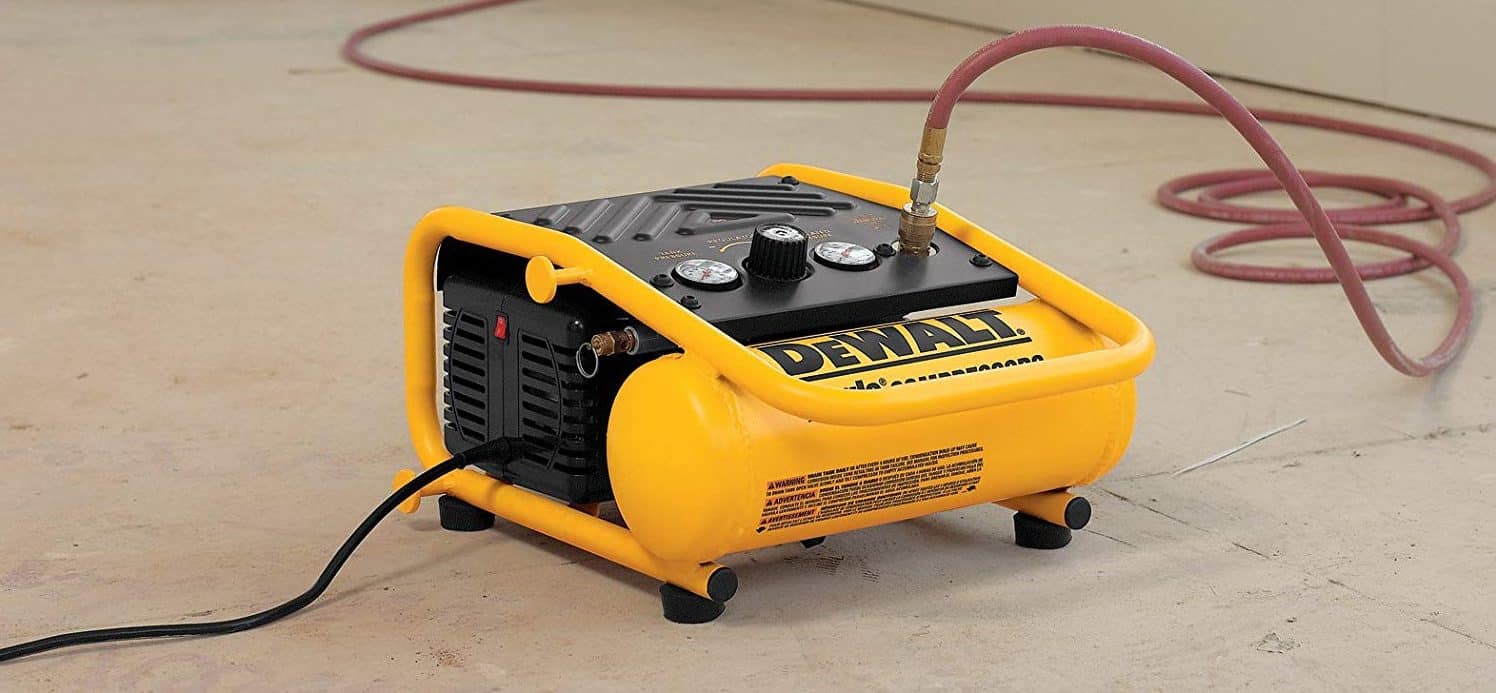
If you’re looking to replace your tired old unit or just need the best small air compressor, you’ve come to the right place. Our experts went through dozens of options to bring you the top models, and we’ve included a price point for everyone.
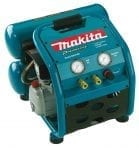 Makita MAC2400
Makita MAC2400
Dual quick connects
Quiet for its size
Built like a rock
Thermal overload protection
 DeWalt DWFP55126
DeWalt DWFP55126
Starts quickly in cold weather
Easy to use
Holds a lot of air
30 pounds
0.9HP motor
Struggles when using two tools
Lack of accessories
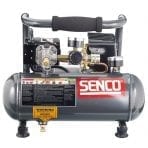 Senco PC1010
Senco PC1010
20 pounds
Very quiet at 68 dBA
CSA approved
The price tag
Only one coupling
Cheap grip on the handle
Ease of use
Lightweight
Plenty of accessories
Three switchable units
Good battery life
Inflation speeds
Can get warm
No extra batteries
Porter-Cable C2002 UMC Pancake Compressor
Simple, but powerful with 150 max PSI and a 6-gallon tank.
150 max PSI
Quick recovery time
Easy to use
Budget-friendly
It’s noisy
Build quality could be better
Kensun Swift Performance Portable Air Compressor
A light-duty unit that works with both AC and DC power.
The price tag
Easy to use
Excellent car compressor
Short AC cable
No auto-cutoff
Screw-on hose isn’t for everyone
Tough roll cage design
Quick recovery
23.5 pounds
Storage pouch
Only one output
Cord wrap can be tricky
California Air Tools CAT-1P1060S Compressor
A quiet an efficient machine with a nice price point.
Excellent recovery times
1.20 CFM at 90 PSI
Quieter than other 1-gallon compressors
Thermal overload protection
Build quality
Confusing instructions
Louder than advertised
Sturdy metal shell
Easy to read LCD
AC/DC power
Hose storage
Limited power
Battery life
Campbell Hausfeld Lightweight Quiet Air Compressor
A twin-stack beast with a quiet oil-less pump.
It’s quieter than most
4.6-gallons
Dual mufflers
Solid regulator
A bit heavy at 38 lbs.
Lack of extras
Price tag
Quick recovery time
Rugged design and roll cage
3-year warranty
Portable design
24 pounds
Limited capabilities outside of trim work
Known to blow fuses
Difficult to work on
15 Small Air Compressor Reviews 2025

He built a house with his own hands. He can definitely distinguish good tools from bad ones and knows the secrets of repair.
Wayne C. MeyersWhen you need to move a nut that won’t budge or put up trim on a remodeling project, air-driven tools are a great way to go. They can produce a lot of power when combined the best small air compressor, but finding the right machine is easier said than done.
If you’re in need of portable air power, you’ve come to the right place. We’ve found some of the top models available and put together a quick guide to help make your buying experience a breeze.

Research You Can Trust
Our experts dug deep and put over 30 small air compressors to the test. After taking into account reviews from users and experts alike, we carefully culled that list down to the best options currently available in the light-duty and homeowner class.
While these air compressors are smaller than usual, some pack a mean punch, and we’ve detailed all the important tech specs to go along with our Top 15 products.
Our top choice from Makita is a beastly little compressor and among the best small compressors on the market today. The Makita MAC2400 is a twin-stack compressor built for the road, and an outstanding option when you need peak performance and reliability.
This compressor is 4.2-gallon twin-stack tank system with a “sustained” pressure of 130 PSI. On the CFM front, you can expect 4.8 CFM at 40 PSI or 4.2 CFM at 90 PSI. You can run two nailers with ease from the Makita MAC2400.
And it’s an oil-lubricated pump unlike other options on our list.
The 4-pole motor is top-tier as well at 2.5 HP and produces 2.1 HP while running.
 But that’s not all…
But that’s not all…
This compressor has three gauges; two in the front for pressure and one on the side to check the oil level.
The quick connect couplers are on the front and easy to access, but the placement of all the components is a bit odd considering the power switch is on the opposite side of the sight glass.
It’s not a deal breaker by any means, but not necessarily convenient either.
While that’s a drag, we love the massive air filter and the discharge tubing.
Its copper finned to help with heat dissipation which means less water in the tank.
Despite its rugged exterior and roll cage design, the Makita MAC2400 is quiet at 79 dBA.
It’s also capable of firing grapes at a high rate of speed as you can see in the video below…
Last but not least is the build quality.
And if you’re familiar with Makita’s tools, you already know what to expect.
The MAC2400 is constructed from high-quality components with a roll cage that protects the more fragile parts.
The gauge panel is metal, not plastic, and even the powder coating is top of the line.
It has a 1-year warranty to go along with a 30-day guarantee.
But truth be told…
This machine will last a decade if you keep it properly maintained.
Compared to other compressors in this class and of this size, the MAC2400 has a reasonable price tag and will definitely deliver when it counts. The fact that it’s quieter than other twin-stacks is a bonus, but it’s about the only thing you’ll get as no accessories are included outside of oil and a few couplers.
If you need to air up tires, soccer balls or want an array of couplers, be sure to check out this handy accessory kit.
Features
Dual quick connects
Quiet for its size
Built like a rock
Thermal overload protection
Gauges & controls are scattered
It’s heavy at 77 pounds
DeWalt is one of the worldwide leaders in power tools, and over the years they’ve expanded their lineup to some interesting products like the FLEXVOLT 60V Chainsaw.
While they don’t have any cordless compressors (yet), the DeWalt DWFP55126 is well worth a look.
The DeWalt DWFP55126 is a pancake compressor with a large 6-gallon air tank. The size makes it a great option for the shop or garage, although it’s portable enough to toss in the back of the truck at just 30 pounds.
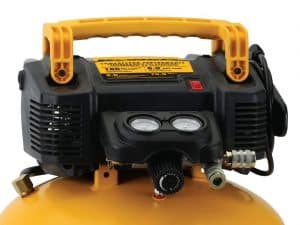 In fact, it has several handy features that make it a joy to use from the cord wrap and rubber feet to the handle up top.
In fact, it has several handy features that make it a joy to use from the cord wrap and rubber feet to the handle up top.
As the company generally makes quality tools, you can expect the same attention to detail with their compressor lineup.
This one is well-built, even if the plastic housing does look a bit cheap. (Which it does, a little.)
It will keep key components covered, however, and is relatively thick. It’s solid, but there’s not much else we can add in regards to the build quality as pancake compressors are simple machines.
Unfortunately, there’s one drawback.
Despite the fact this particular model is rated at a maximum of 165 PSI, there is a slight hindrance depending on your needs.
The compressor can produce 2.6 SCFM at 90 PSI, but will take around a minute and a half to hit that level. The maximum pressure will take 3-5 minutes as shown in the video below.
That’s not bad by any means, but not what we would consider speedy as the DWFP55126 only has a 0.9 HP motor.
You’ll want something a little more powerful for full-time use, although it’s a great compressor for brad nailers like the DWFP12231 and other low-powered air tools.
We hesitate to call this one workhorse, but it runs and is one of the quieter oil-free models at 75.5 dBA.
It also has dual couplers with a high flow regulator.
You won’t have to deal with much maintenance, and we think you’ll appreciate how quickly it fires up in colder weather.
Homeowners in the market for a light-duty compressor will definitely want to keep the DeWalt DWFP55126 on their radar.
It’s ready to roll straight out of the box once you attach a hose (not included). It has a 1-year warranty with free service to go along with a 90-day money back guarantee.
Features
Starts quickly in cold weather
Easy to use
Holds a lot of air
30 pounds
0.9HP motor
Struggles when using two tools
Lack of accessories
The name Senco may not ring out like Makita or DeWalt, but it’s a moniker you’ll remember after using a few tools from their vast lineup. The Senco PC1010 is another option that’s lightweight and won’t break the bank provided you don’t need a compressor for heavy-duty work.
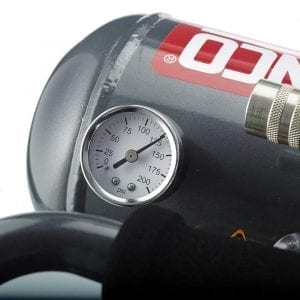 Do you make a living selling airbrushed works of art on ETSY or need a small compressor for projects around the house?
Do you make a living selling airbrushed works of art on ETSY or need a small compressor for projects around the house?
If so, the PC1010 may be the solution for you as it only weighs 20 pounds. It has a 1-gallon tank with a max capacity of 125 PSI which gets its air from a 1HP oil-less motor. That’s peak, however, as it can only do .5HP while running.
The size of the Senco PC1010 makes it an instant option for the best small air compressor, but you’re not just limited to crafts or airing up the occasional tire.
It’s rated for around 20-44 drives per minute and capable of delivering 0.7 SCFM at 90 PSI. According to consumers like Charles, the “compressor can fire 10-12 brad nails at 60 PSI before the compressor kicks back on.” Not too shabby for its size...
With some compressors, you’d be left wondering about the recovery time, but not this one. The pump-up time lis listed at 128 seconds and a recovery time is around 35 seconds.
Still on the fence about what this little machine can do?
This quick breakdown of the Senco PC1010 may help ease your mind…
The Senco PC1010 comes with the usual extras out of the box including a regulator, pressure gauge, air filter and a 1/4” coupler.
That will get you started, but you’ll quickly find yourself hitting up the hardware store when it’s time to air up a ball or tire, or clean out the gutters.
If you’re sans accessories, this 17-piece inflation kit will undoubtedly do the trick.
You can check out the owner’s guide for the Senco PC1010 here.
Features
20 pounds
Very quiet at 68 dBA
CSA approved
The price tag
Only one coupling
Cheap grip on the handle
Makita makes some of the best air-driven tools on the market along with the equipment that powers them.
When it comes to compressors you can toss in the truck or store under a bench; the Makita MAC700 is an option that should be very high on your list.
The MAC700 lives up to its namesake as it’s a “Big Bore” compressor that tips the scales at 52 lbs. It’s still portable, however, and even sports a handle which makes lugging it around easier.
This powerful compressor has a 2.0 HP motor and sturdy cast iron pump rated to run at 1,730 RPM. That will improve the lifespan of this tool while keeping things relatively quiet at around 80 dBA. You can find out more about the motor and tech specs in the user manual.
Don’t believe us?
See for yourself…
Another highlight of the motor is the fact it’s oiled, so it will run cooler and last longer than oil-less pumps.
The oil sight glass takes care of the guesswork when it’s time to check the levels – something many of us forget to do.
We also like the low AMP draw on this model which cuts down on the chance of accidentally tripping a breaker.
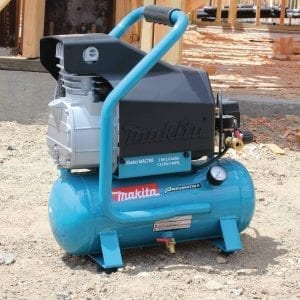 When it comes to performance…
When it comes to performance…
The MAC700 Big Bore is rated at 1.7HP running with a maximum PSI of 130.
The company claims it can deliver 3.3 CFM at 90 PSI or 3.8 CFM at 30 PSI.
It may get a little warm with use like any other compressor, but the design and features like copper finned discharge tubing help keep heat and moisture in check.
This hot dog style compressor is an excellent choice for homeowners and professionals alike. It won’t hang with twin-stacked compressors or wheelbarrow models on the job site, but it’s hard to argue with what it offers up for the price.
The compressor comes with a 1-year factory warranty although there’s not much included in the box except for oil and a 1/4” coupler. If you do happen to need a hose, we highly recommend checking this one out.
Features
Cast Iron oil-lubricated pump
Strong 2HP 4-Pole motor
Large air filter
Easy to maintain
Thermal overload protection
Heavier than other small compressors
Design is top heavy
User manual is lacking
It’s hard to find an oil-free compressor that has enough power for the job site but is still quite enough to make most homeowners happy. Bostich managed to pull off that rare feat with the BTFP02012, a pancake compressor rated at around 78 dBA.
This compressor falls into the homeowner category but still delivers enough horsepower to be of use on job sites. It has an oil-free pump, so you will not want to overwork it although keeping it maintained will be a breeze.
The high-efficiency motor starts easily in cold weather, and you’ll get two couplers to work with instead of just one.
Just how quiet is it?
While the BTFP02012 is rated at 78 dBA by Bostich, you’ll want to take that measurement lightly. As you can see from the video below, it’s a little loud compared to similar models.
That shouldn’t be a deal breaker given the price, and the fact distance makes a big difference. But it’s something to keep in mind nonetheless.
The compressor is average when it comes to weight and size for a pancake compressor at 29 pounds. We can say the same about the warranty as it’s the usual 1-year standard.
You’ll get a maximum of 150 PSI from the 6-gallon tank which delivers 2.6 SCFM at 90 PSI. That’s enough for two nailers or staplers once you factor in the high flow regulator.
Overall, this compressor is solid albeit a little basic out of the box.
But only if you pick this particular kit...
The Bostitch BTFP02012 is available in several combo packs which range from kits featuring a single tool to several or a big brad nailer. If you already have tools on hand, but need accessories the Premium Compressor Kit is an excellent option as well.
Affordable price tag
Dual couplers
Multiple options
Works well in cold weather
0.8 HP motor
Short power cord
Our first cordless air compressor isn’t on par with the rest of the pack when it comes to power or job site performance due to its size.
What the Oasser Electric Inflator lacks in oomph, it more than makes up for in the portability department and it sports some very nifty features to as well.
At first glance, it would be easy to mistake the Oasser portable inflator for a small cordless drill or tool.
The pistol grip design doesn’t scream “air compressor,” but this little unit is surprisingly powerful. It can produce a max PSI of 130 which makes it an excellent fit for smaller tires and other types of inflatables.
The unit comes with attachments with a Toy Nozzle, Ball Needle, and a Presta Valve.
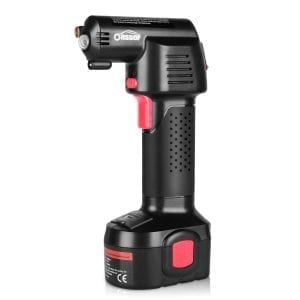 How powerful can a handheld machine be?
How powerful can a handheld machine be?
This portable inflator draws its power from a 2,220mAh battery pack. It’s rated to refill four 185/70R14 tires, and when the battery finally dies, you can recharge it in the car or your home.
Small inflatables are no match for this one, and it can handle 25 bicycle or 10 motorcycle tires as well. We found the battery life is excellent, and the flow rate isn’t bad at around 23 liters per minute.
Do you want an inflator that’s easy to use?
It doesn’t get any simpler than this one, thanks to a built-in LED pressure gauge. This ensures you can monitor the airflow night or day on the large display. There are three modes of measurement as well with PSI, Kg/cm², and BAR. The design itself goes a long way in the ease of use department--even if the hoses can be a little finicky at times.
With a weight of 2.7 pounds, this inflator is portable and the perfect to keep in your vehicle.
We like the LED pressure gauge and the built-in light under the hose as well. The consumers we consulted found them to work well and be a valuable feature to have.
What’s really cool about this one?
You’ll never have to deal with the dangers of changing tires in the dark again. The Oasser portable pump comes with a storage bag, user manual, a 4.72-inch hose, and a 13.78-inch hose along with the aforementioned valves and chargers.
Ease of use
Lightweight
Plenty of accessories
Three switchable units
Good battery life
Inflation speeds
Can get warm
No extra batteries
Porter-Cable’s C2002 UMC is another pancake compressor built to light-duty work in the shop or around the house. The company didn’t break any new ground with the design, but it offers plenty of value in a portable package.
The C2002 is an ordinary pancake compressor and is of average size at around 34 pounds. It has thick rubber feet on the bottom to prevent it from walking away from you and cut down on the sound when used on certain surfaces. Those feet also help to protect floors, so they are scuff-free.
A plastic shroud on top keeps all the vital components covered, although it’s not the most durable setup we’ve come across.
Like a needle in a haystack…
While the company didn’t put a horsepower rating on this product, we dug one up.
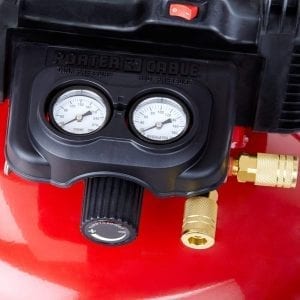 Unfortunately…
Unfortunately…
It’s a bit disappointing. Check this out:
The running power is only .8 HP which puts it at the back of the back in terms of power. The oil-free pump and 120V motor are positives, however, especially if you don’t dig maintenance or tripped breakers.
The 6-gallon tank on this compressor has a maximum PSI of 150, and the cut-in restart kicks in at 120 PSI. As for the SCFM ratings, you can expect 3.5 SCFM at 40 PSI and 2.6 SCFM at 90 PSI.
Not too shabby given the motor size!
On the downside…
The Porter-Cable C2002 is a bit louder than its 82 dBA rating implies. It won’t run you out of the house, but it’s far from what we would consider quiet.
Features for this compressor include dual quick connect couplers, a cord wrap, and a sturdy handle to help you lug the pump around.
It also has dual gauges to go along with a regulator and drain valve.
These are nice, but very standard features you’ll find on all the best small air compressors. There are no standouts in the bells & whistles department. Nor will you get any extras in the box.
This compressor is a bit basic but, according to our research, performs as advertised with little to no maintenance required. It has a 1-year warranty in case things go south and we like the fact the company puts out solid user guides as well.
It’s also an ideal choice for air-driven tools like the Porter-Cable PIN138, a 23-gauge Pin nailer that would be a great companion for your new compressor.
The C2002 is sold by itself or in bundles available with accessory kits or an 18-gauge brad nailer.
Features
150 max PSI
Quick recovery time
Easy to use
Budget-friendly
It’s noisy
Build quality could be better
Air compressors are generally bulky by nature, and even the most portable models can still take up a considerable amount of trunk space. If you’re in the market for something a wee bit more compact, Kensun has the answer with the Swift Performance compressor.
We’re going to cut to the chase with this one.
The company dropped the ball in the design department.
The Kensun Swift is far from sleek with a basic plastic shell, but certainly portable and extremely easy to use. It’s not one you’ll want to bang around, but it should hold up well under normal duress.
Have you ever had to dig for quarters to use those gas station air machines that rarely work and cut off prematurely?
Well, the days of searching for an air machine are long gone if you have the Kensun Swift. The unit can run off a regular 110V plug from inside your home.
 But that’s not even the best part.
But that’s not even the best part.
It also works with any 12V car outlet which gives you air on the go.
The Swift has an old-school analog pressure gauge with an accuracy of 35 PSI +/-1PSI. It’s small but capable considering you can squeeze 35-minutes out of it at 35 PSI as well.
You won’t be able to blow out gutters with this budget-friendly compressor, but it’s quicker than a hand pump and will run circles around similar portable solutions.
Other highlights of this compressor include a screw-on 31-inch air hose and three nozzles that can handle anything from a beach ball to inflatable pools.
The DC cable is over 10-feet long, but the AC cable is a little short for our liking at 3.3-feet.
The Kensun Swift portable compressor comes with a carrying case and a 2-year warranty. While that information isn’t out in with the listing, it’s the first thing mentioned in their user manual.
If you prefer a different hose, we recommend giving the Slime 20332 hose adapter a look.
Features
The price tag
Easy to use
Excellent car compressor
Short AC cable
No auto-cutoff
Screw-on hose isn’t for everyone
Are you a professional remodeler that deals with a lot of trim work around doors, baseboards, and windows?
While most small air compressors can handle trim, the Bostich CAP1512-OF is built for it--making it one of our favorites.
The build quality of this compressor is what initially caught our eye, but before we talk about durability, let’s take a look at the specifications.
The CAP1512-OF is rated to run at 1.5 HP and has a low amp motor to prevent breaker trips. It delivers 2.8 CFM at 90 PSI from the 1.2-gallon tank which has a maximum pressure of 120 PSI.
The compressor has more than enough power to fill up tires, fire nails or even fill up an inflatable hot tub.
Back to the build quality…
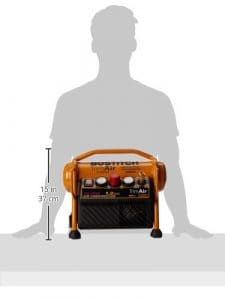 The Bostich CAP1512-OF is perfect for construction sites or remodeling jobs.
The Bostich CAP1512-OF is perfect for construction sites or remodeling jobs.
The roll cage prevents damage to the front panel if it happens to tip over while also giving you three handles to work with.
A plastic shroud covers the motor and helps protect the innards, and non-marring rubber feet help minimize vibrations while keeping floors scuff-free.
The design is fancy and functional. But we did find the placement of the cord wrap may throw you off as the cable is thick and bit stiff at first. You can find more out about the internals and parts in general through the user manual.
Features are another area that helps set this small compressor apart from the rest.
While you only have one coupling to work from, there are two gauges and a large power switch. There is also a “tool pouch” on the back that can hold a few attachments and a loop to help keep your hose in place when not in use.
You can’t see these in any of the photos, but you can get a good look at them in the video below. You may also want to look into getting a tool bag to help you keep your accessories tidy.
We feel this compressor is more suited to pros than the average Joe that just needs something for projects in the garage.
While the tank isn’t the largest, the recovery time is quick, and there’s plenty of horsepower.
On the downside…
There’s only one output so you can’t hook up two nailers at a time.
The Bostitch CAP1512-OF comes with a 1-year warranty, but no extras. If you need hose or accessories, this kit from WYNNsky is an affordable option to get you started.
Features
Tough roll cage design
Quick recovery
23.5 pounds
Storage pouch
Only one output
Cord wrap can be tricky
California Air Tools is known for making affordable machines that can hang with higher-end models.
The CAT-1P1060S is no different in that regard.
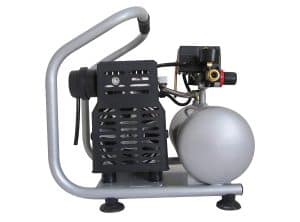 But it’s considerably quieter than any other compressor in its class. We think that counts for something.
But it’s considerably quieter than any other compressor in its class. We think that counts for something.
At 29.5 pounds, the California Air Tools CAT-1P1060S is portable, if a little awkward to carry due to the design. It’s not a “leg bumper” or overly top heavy, but noteworthy nonetheless.
The front of the unit has the hot dog style tank along with a regulator and quick connect coupling.
There’s no shroud or covering over those components although there is some protection around the pump and other parts.
Can you really believe the hype?
This compressor is rated by the manufacturer at around 56 dBA. That’s quiet, but unfortunately isn’t on the money as various tests have shown.
Don’t believe us?
Check out the CAT-1P1060S in action…
Numbers don’t lie and we found it’s closer to 68 dBA than 56 decibels. That’s a bit of a disappointment. Although, those numbers will vary and it’s still quiet enough to talk around. It won’t split your eardrums like a larger machine and maintenance will be minimal as well.
As this model is in the budget class, there are no bells & whistles that stand out compared to similar small air compressors.
The specifications are solid, however.
It’s capable of 1.20 CFM at 90 PSI. It has an oil-less system rated for 1.2 HP during peak conditions but runs at 0.6 HP as it provides air to the 1-gallon steel tank. The recovery time from 90 to 120 PSI is 15 seconds, and you can go from empty to full in less than a minute.
The company decided to keep the extras spare on this model, so there’s nothing in the box aside from an air filter and a manual (which you can download directly by clicking here).
It’s ETL certified with a 1-year warranty, but if this is your first compressor, you’ll need to purchase a hose at minimum. While there are plenty of options to choose from, Giraffe has a fine line of compressors accessories including some tough hybrid hoses.
There’s a lot to like about the California Air Tools CAT-1P1060S although it’s a mixed bag in a few areas.
The build quality could be better, and we aren’t huge fans of the design. That said, it’s quiet and produces plenty of air depending on your needs while sporting an attractive price point.
Features
Excellent recovery times
1.20 CFM at 90 PSI
Quieter than other 1-gallon compressors
Thermal overload protection
Build quality
Confusing instructions
Louder than advertised
Our second option for Oasser is far different than our first. While both are portable and easy to stow away in a car or truck, this one is perfect for two-wheeled vehicles.
It’s also tougher.
It can still handle a flat on the side of the road but is more portable than its rechargeable sibling.
This compressor is in line with the Cycplus A1 from a design standpoint. It’s a small cylinder a little over 7-inches long and around 2-inches wide. It has some weight as the shell is made from stainless, not plastic so it can take a bit of abuse.
We also like the fact the controls are all on the front aside from the outlet and the small, but easy to read digital display.
Plus, it’s packed full of features.
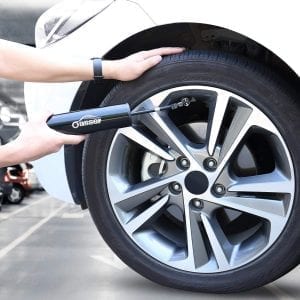 Whether you’re pumping up a bike tire or need to inject some air during a roadside emergency in your SUV, you can rest easy with the Oasser portable air compressor.
Whether you’re pumping up a bike tire or need to inject some air during a roadside emergency in your SUV, you can rest easy with the Oasser portable air compressor.
You can preset the pump to hit the number you need, and the display gives values in four types of units with BAR, PSI, KPA, and Kg/cm². That’s standard for this type of gauge, and we’re pleased to say the backlighting is solid on this model as well.
Another perk of this pump is that it has not one, but two LED flashlights which work independently of each other.
The pressure is 150 PSI max with an air flow rate of 13 liters per minute.
As you’d expect, you can charge this one up in any vehicle with a 12V DC plug or from a wall outlet, and it will go from zero to hero in around 1.5-hours.
The Oasser portable air compressor has a 1-year warranty and a better design than other small compressors of this nature.
It’s still limited to a degree but will blow up a tire or inflatables like those cool ginormous beach balls.
It comes with the usual array of accessories as well, including a storage bag, hose, dual chargers, and a few needles and nozzles for airing up various inflatables.
Features
Sturdy metal shell
Easy to read LCD
AC/DC power
Hose storage
Limited power
Battery life
In our reviews, we felt it was important to break things down into a few key areas and keep it simple. We are going to focus on build quality, horsepower, and features. As you might suspect, there’s more to build quality than a sturdy roll cage or warranty.
Even the best compressor can crack under pressure if a weld fails or the people in charge of quality control were napping when your unit rolled across the assembly line.
Horsepower isn’t all it’s cracked up to be either.
But don’t worry…
We’re going to explain CFM along with the two types of pumps found in modern compressors.
Features are a little easier to wrap your head around with air compressor as it’s a case of your needs vs. your wants in some cases.
Ask yourself:
Do you really need dual couplings if you’re only airing up tires or blowing up pool toys in the summer?
Decisions like this can save you a few bucks while ensuring you find the compressor that’s right for you.
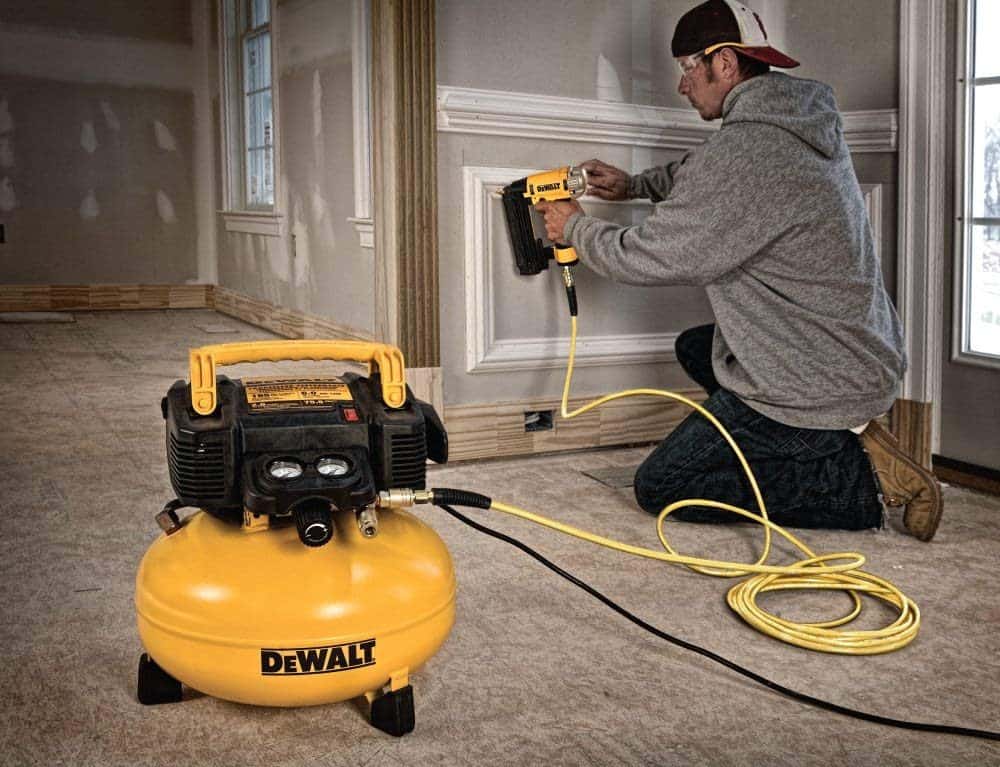
Choosing an excellent air compressor can be tough considering there are thousands of options available at any given time.
Consumers that are experienced with tools can navigate the landscape with ease, but beginners can quickly find themselves stuck in a rut.
Our guide ensures you’ll find the perfect small compressor to suit your needs. We’ve also included a few tips for maintaining your new tool.
Do you need an air compressor that can air up anything or one for a specific task?
That’s the first question to ask yourself as there are hundreds of uses for an air compressor.
But, smaller models generally have a distinct purpose.
If you plan to use your compressor for the occasional DIY project, you won’t need the huge tank. The same goes for consumers who need something that can handle an airbrush for craft work, temporary tattoos, or even nails.
Need to air up bike and wheelbarrow tires?
Well, a 50-pound compressor may be overkill for pool toys and the occasional tire.
A trim nailer or airbrush can run on a variety of compressors, but when it comes to impact wrenches or chipping hammers – you’re going to need more power.
Thanks to today’s tech, you no longer have to rely on a tall tank that eats up space in the shop. You still have to consider the tools you plan to use before settling on any style of compressor, however.

Once you understand the type of compressor you’re after, it’s time to consider the styles. As we’re dealing with the best small air compressors, a few models are automatically out, so we’re going to focus on the most popular pint-sized options.
Regardless of their size, an air compressor is designed to provide you with air when you need it most. For some, that may be a short burst with a nailer or airbrush.
But that just won’t do if you’re trying to paint a wall or chip concrete.
Power certainly plays a part in that, but so does the tank size.
Simply put, the larger the tank, the more air it will hold.
That usually means the compressor will kick on less, so you won’t have to stop work to wait on the tank to refill. Every tank on our list ranges from 1 to 6-gallons although that’s not the number you need to hone in on.
What’s the most important number?
That would be CFM or SCFM which stands for cubic feet per minute.
The CFM rating tells you how much air the compressor can deliver, and it’s a number that correlates directly to many air-driven tools.
An Angle Die Grinder may require 24 CFM at load while a roofing nailer may clock in at around 2.5 CFM.
Again, this is an area where you need to think about the types of tools you’ll use beforehand. Although you don’t have to match every tool in your arsenal to the compressor.
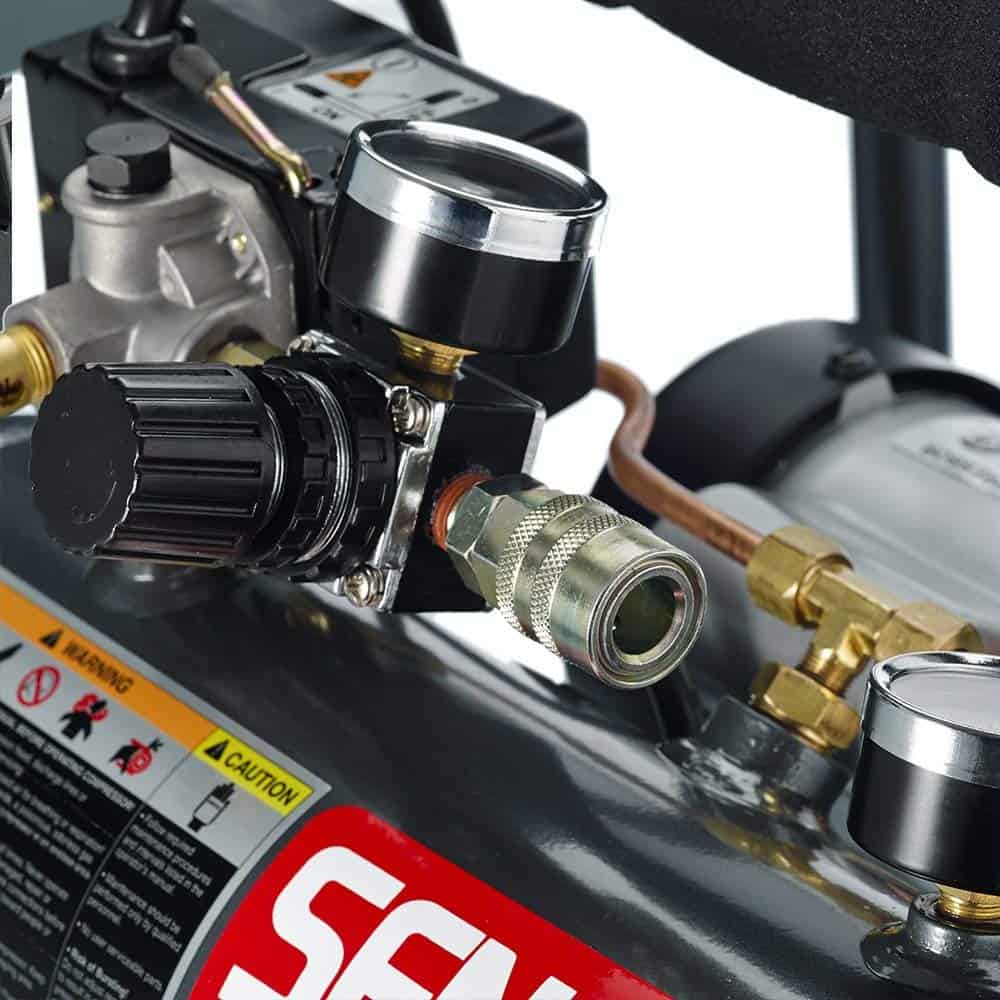
How much horsepower you need ties into how you plan to use your compressor and the types of tools you’ll run.
If you don’t like long refill times, you’ll want a powerful motor.
It’s also an area where you can’t rely solely on the old “HP” measurement as it isn’t always accurate.
However, you have to take the box ratings with a dose of salt.
Unfortunately, there’s a catch…
If a compressor says it’s 2HP, that’s more than likely its peak power… not the running power.
It’s also a number that can be very hard to dig up.
The same goes for “Duty Cycle” which tells you how long a compressor can run continually over a set period of time.
Have you ever used air-driven tools in the pro class?
You could be in for a rude awakening if you plan on firing up a grinder for the first time.
The tool alone is loud enough, and you’ll have to deal with the compressor running to build up pressure as well. Smaller air compressors are far quieter than stationary models although you still need to consider the decibel level if working indoors.
Most compressors in the “small” range usually register around 80 dBA. That’s not as noisy as your lawn mower, but a roar compared to something like an AC unit.
If you want a machine that’s as quiet as the compressor on your refrigerator, you’re out of luck. Although we think you’ll be impressed by just how quiet some models are today.
The other thing you have to consider are misleading decibel measurements given by manufacturers. In some cases, it’s an oversight as testing conditions can vary, but it’s a pure marketing gimmick in other instances.
Can you believe those numbers on the box?
Most of the time, those measurements are close. But, when in doubt, look for videos that show the compressor in action if noise levels are crucial to you.
If you’d like to learn more, this chart gives you a range from 0 to 120 dBA.
Another option our experts recommend for those concerned about their hearing safety is to invest in a quality pair of noise reducing headphones. Even something as simple as some basic foam earplugs could help.
Oiled Vs. Oil-free Pumps
Aside from exotic hybrids and battery-powered units, the best air compressors, regardless of their size, will have an oiled pump or one that’s oil-less.
For decades, compressors that require oil were the only way to go, but oil-less models have quickly gained a lot of ground.
If you plan to use your air compressors daily, we highly recommend looking at oiled models. For light-duty work and home use, you’ll probably be fine with an oil-less model as both can provide the same amount of power.
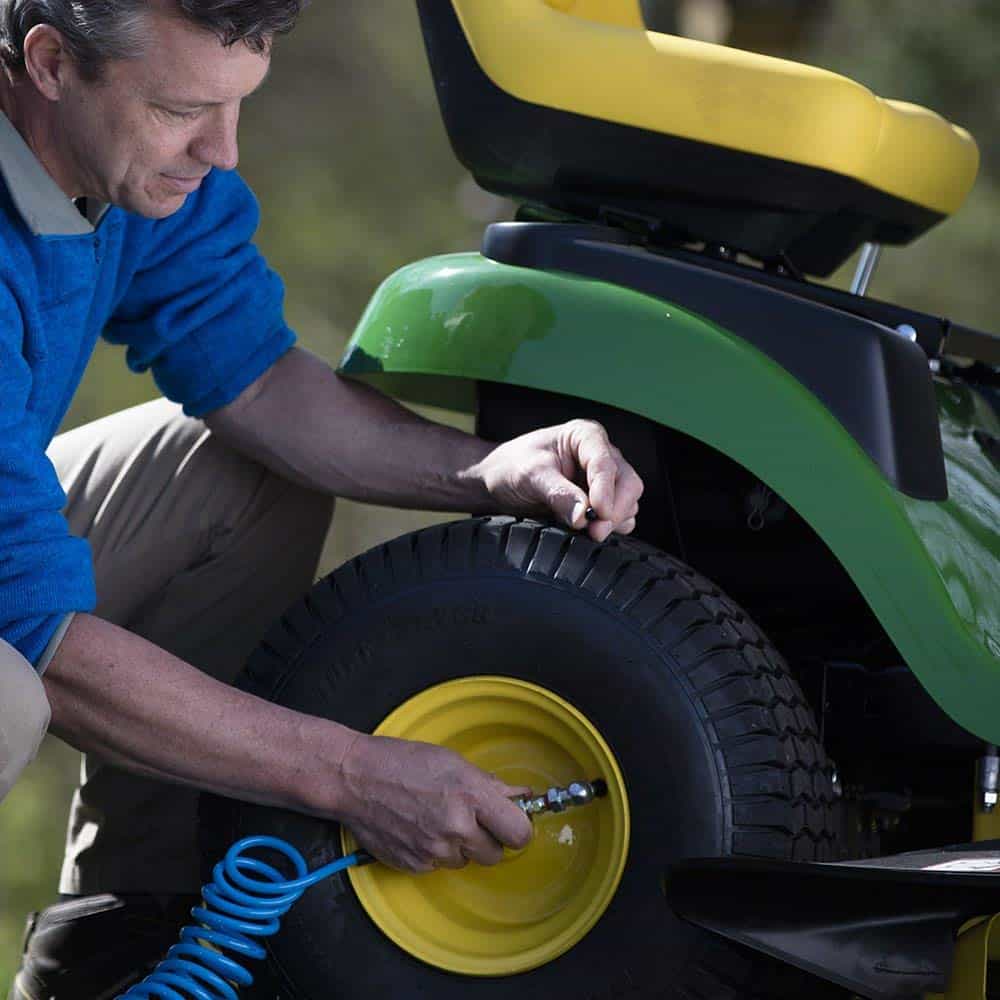
Whether you’re buying an air compressor to use on models or to send out on the road with your crew – build quality is paramount.
Compared to other tools, warranties generally aren’t over a year in the compressor world, so the quality of the components used along with the frame and other features are something you’ll want to pay close attention to.
Any part that’s cast iron will last longer although that will increase the overall weight of the machine.
A system that’s oil-less will require less maintenance overall, but there’s a trade-off as pumps that are oiled have a longer lifespan.
The type of oiler matters as well, and pressure-based systems are the best if given the option.
When it comes to the frame, take a hard look at the quality of the welds. You should also look at the thickness of the shroud or housing around the gauges and other areas with delicate parts.
Plastic is prone to crack, and even a roll cage can will falter if the quality control is off.
You can’t do that online, but you should do give the compressor a thorough inspection before you ever plug it in.
You don’t need to be He-Man or She-Ra to lug around any compressor on our list as most range around 30 to 50-pounds. That said, some are far easier to carry than others due to their design and how the weight is distributed.
Compressors with handles tend to make life easier, but not if they are top-heavy and awkward to carry.
A compressor with a padded handle may draw you in but beware as foam breaks down quickly.
Rubber grips may not be as comfortable, but they will last longer, and you can always add some padding of your own to hard steel handles.
Also consider how often you plan to use the compressor, and if it’s one you’ll move frequently.
Even the most inexperienced consumer can use an air compressor after giving the manual a quick look.
They aren’t complicated machines although those manuals can make things difficult at times. However, some are easier to use than others due to their design and where the controls are placed.
Do you really want to reach around all four corners to control your compressor?
We didn’t think so….
When ease of use is a top priority, look for compressors with dual gauges and couplings.
Even if you only use one air tool at a time, it’s handy to have an extra at the ready if you’re doing trim work or other tasks.
Connections aside, drain valves and other “common” components can quickly ruin your experience so look before you leap when settling on a wild design.
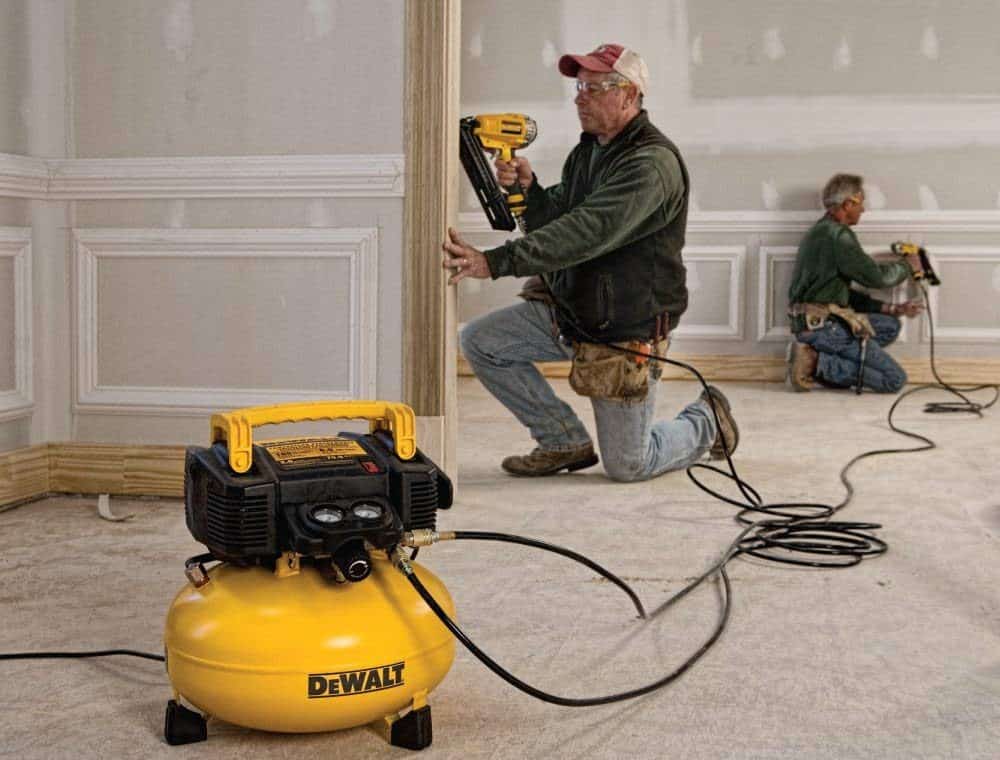
When you find yourself torn between two products, features are a great way to help thin the herd.
While every compressor will have rubber feet and at least one gauge or coupling, some come with features that help separate the best from the rest.
Many of the top small air compressors will have dual couplings or roll cages to prevent damage to the machine. That latter is essential as compressors of this nature are prone to tip over, especially if you’re tugging on the hose.
Thermal overload protection, tool hangers and even the size of the air filter can make a huge difference as well.
And don’t forget about high-quality gauges and sight glasses.
Those are just a few things to look for on small air compressors, and the list changes considerably when you get into handheld solutions.
If you opt for a glove box compressor, pay close attention to the battery life, charging times and the digital readouts. Some are easier to read than others, and the build quality is of the utmost importance with handheld units as well.
Missing Measurements
We’ve talked about the specifications you should look for when shopping for a new compressor, and if you’ve made it this far, you may already know which features are right for you. One thing we didn’t cover is an area manufacturers tend to leave out.
We refer to these as “missing” measurements…
Sounds pretty bad, doesn’t it?
Running power is one hidden measurement to look for and something we briefly touched on along with the duty cycle.
Now, here’s the rest of the deal:
Every company will slap the maximum PSI rating on the side of their box, but how many actually tell you the recovery time? This is the amount of time it takes your compressor to refill.
It’s very important, but guess what?
You rarely ever find in marketing material.
Plenty of manufacturers also hype their machines as “low voltage” which means they won’t trip breakers and you can use them with extension cords.
Does that impress you?
It should, but do they actually tell you how long the compressor cord is to begin with? That’s another missing measurement that matters more than you’d think.

Buying any new tool can be exciting, but daunting when it comes to certain types of equipment. That’s because you could be left high and dry when you open the box and find out what’s shown in the photo isn’t exactly what you’ve received.
We’re not talking about a missing product manual either…
Unless specifically mentioned, most air compressors do not come with a hose. It’s something you need in order to use your new compressor and the same goes for adapters or couplings.
If you’re getting a compressor that uses oil, you’ll need to pick up some of that as well, but only use the kind recommended by the manufacturer.
In a nutshell, what you “might” need all boils down to the type of compressor you choose and your overall needs.
You can pick up an adapter at the hardware store, but finding a hybrid 20-foot flex hose is a different story. With that in mind, we’ve included several excellent accessories to go along with our picks for the top small air compressors below.
An air compressor may look rather harmless compared to a tool like a chainsaw, but you still need to proceed with caution. Most of the air compressors we’ve discussed are more powerful than what you’d use for a model car or applying makeup, so you’ll want to keep these tips in mind…

Safety tips
Using an air compressor isn’t difficult, and common sense goes a long way. While it might be fun to shoot various objects from the hose, it’s not recommended.
The first thing you should is read your instruction manual, and then check all the fittings or any bolts to make sure they’re tight. Both can rattle loose during shipping and cause major issues when you flick the power switch.
If the outer box is damaged, inspect the compressor carefully before ever plugging it in.
On that note, always use the proper plug and don’t try and daisy chain cheap extension cords together even if it’s a low amp system. If you’re using a machine with an oil-free pump, there’s not much to do in regards to maintenance, but you should still check out what the manufacturer of your compressor suggests. This can often be found in the user manual.
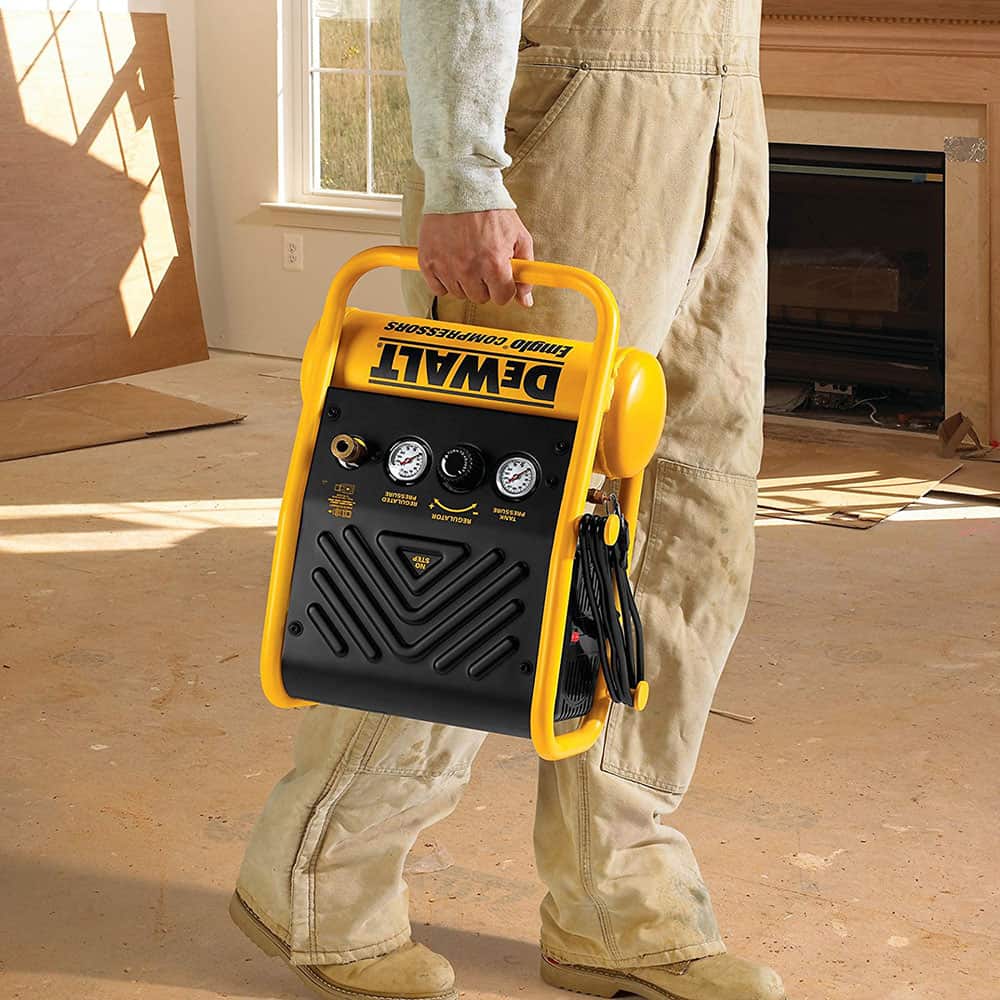
So, you’ve finally got your new compressor and are ready to pump up a flat or inflate a pool.
Well, not so fast.
If you’ve purchased a compressor that uses oil, you need to break it in first,
And, some oil-less models recommend a similar procedure as well.
Before you get too excited, the break-in period is rather short, and the process is simple.
The first thing you’ll need to do is get the right weight of oil and fill up your new air compressor to the proper level.
Once it’s topped off, open the drain valve, plug it in and let it run for around 20-minutes and you’re good to go.
Easy peasy.
Again, the process may vary from manufacturer to manufacturer so always refer to your manual beforehand.
The Final Word
We hope our research has helped you make an informed buying decision and tried to include an option and price point for everyone.
While there were a few styles we didn’t touch on like wheelbarrow compressors, every model on our list is designed to be portable and easy to tote around with one or two hands.
With that in mind, here are two options we feel stand out…
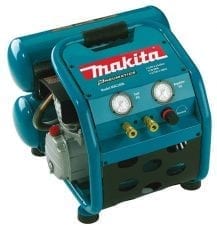
If you’re looking to replace your tired old unit or just need the best small air compressor, you’ve come to the right place. Our experts went through dozens of options to bring you the top models, and we’ve included a price point for everyone.
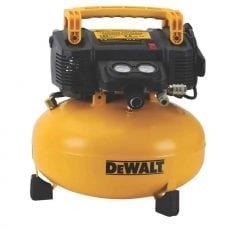
If you’re looking to replace your tired old unit or just need the best small air compressor, you’ve come to the right place. Our experts went through dozens of options to bring you the top models, and we’ve included a price point for everyone.

If you’re looking to replace your tired old unit or just need the best small air compressor, you’ve come to the right place. Our experts went through dozens of options to bring you the top models, and we’ve included a price point for everyone.
Yes, but it's not recommended if you need peak performance and want to keep your warranty intact. A power fluctuation could potentially damage the machine, and while it will work in a pinch (with some experimentation), it is not something we recommend.
To a degree, but it all depends on your usage. Due to their design, a compressor motor kicks on when the air level in the tank drops below a certain level. The larger the air tank, the less wear and tear on the motor, so go for a larger tank if strain is a concern.
If you use your compressor regularly, changing your filter weekly would be a good practice to get into. If you notice any damage to the filter, replace it immediately, and it never hurts to give it a shake even being stored for extended periods of time.
When this happens, you need to check the outlet and ensure it has enough juice for the job. Long extensions cords can also cause a drop in power, so pay attention to the length even if the manufacturer says their machine is extension cord-friendly.
If it isn’t the plug, and the problem persists shut off the compressor. Go back to square one and read the manual or call customer support if needed.
If you have an oiled compressor, the product manual should tell you how often you’ll need to change it and the type of oil you’ll need to use. It varies depending on the type of compressor and by how often you use it as well.
We realize that’s vague, but this is one area where you should refer to your manual as each manufacturer has different specifications for their pumps.
